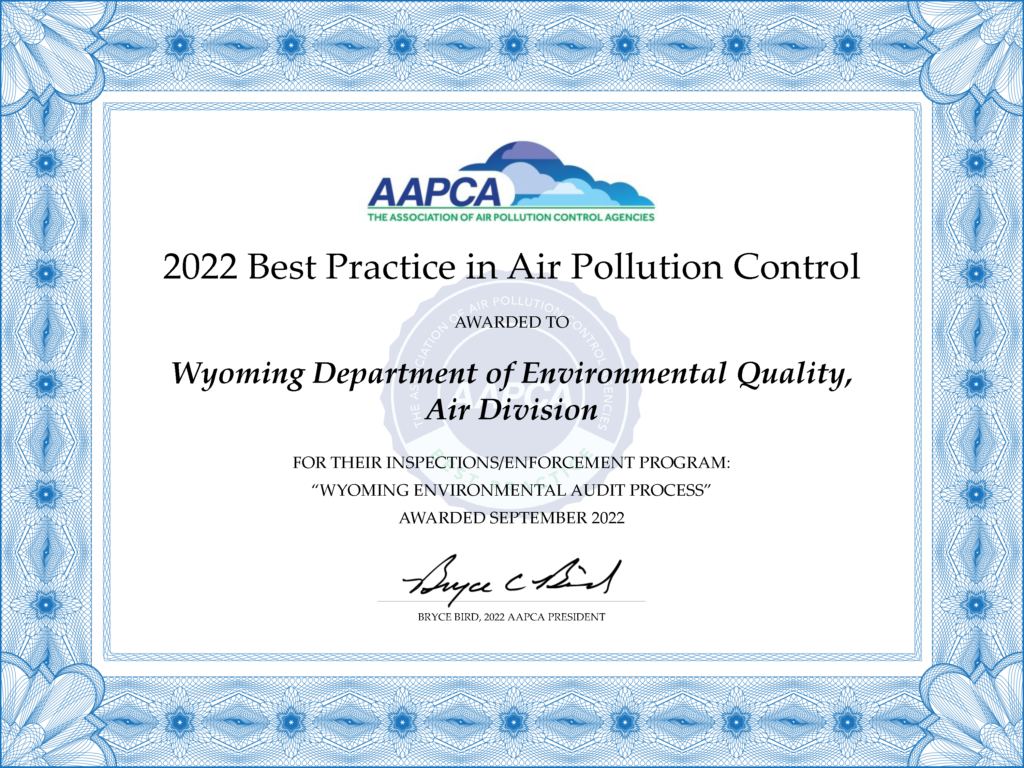
By Kimberly Mazza
CHEYENNE – The Wyoming Department of Environmental Quality’s (DEQ) Air Quality Division (AQD) has been recognized in the newly released 2023 edition of “State Air Trends & Successes: The StATS Report.”
The annual publication, which has been issued by the Association of Air Pollution Control Agencies (AAPCA) since April 2017, looks at the significant improvement in air quality that has been achieved in the United States, focusing on the central role of state and local air agencies.
In the report, Wyoming is listed for reducing emissions and for receiving the Best Practices award in Air Pollution Control.
“It goes without saying that these two go hand-in-hand,” said Nancy Vehr, AQD’s Administrator. The ingenuity and innovation of DEQ’s air quality team has played a large role in the reduction in emissions for Wyoming.”
The AAPCA’s Best Practices Award recipients are recognized for their ground-breaking technology, innovative approaches, and exemplary operations in the field of air pollution control, with particular focus on activities that are directly transferable to the operation of an air pollution control agency.
The Wyoming AQD received the award in 2018 for their Inventory, Monitoring, Permitting, and Compliance tracking (IMPACT) Web-based Data System and more recently at the AAPCA’s 2022 Fall Business Meeting for their Environmental Self-Audit (ESA) program.
The AAPCA, which represents nearly 50 states and local air agencies, is a consensus-driven organization focused on assisting state and local air quality agencies and personnel with implementation and technical issues associated with the federal Clean Air Act.
Each year, the AAPCA seeks nominations from public agencies, private entities, and individuals to identify groundbreaking technology, innovative practices, and exemplary operations in the field of air pollution control. An agency is selected and presented the Best Practices Award.
“This is a significant recognition and reflects the hard work and dedication of the AQD to find innovative ways that ensure clean air for the state of Wyoming,” stated DEQ Director Todd Parfitt.
Lars Lone is the Air Compliance and Enforcement Program Manager and oversees the ESA program.
According to Lars, 18 percent of the 25,000 facilities the DEQ’s Air Quality Division regulates state-wide have joined. “That’s 4,600 facilities,” he noted.
Lars stated that the focus of the AQD is clean air, and that the ESA program supports that objective.
“The ESA program encourages companies to prioritize clean air; to recognize their problems, and to fix them. When companies do a self-audit, violations can be discovered and addressed quicker, meaning less impacts on air quality,” he said.
The program also encourages companies to advance new or alternative methods and capabilities to avert future non-compliance issues.
The results have been self-evident.
ESA has eliminated 4,000 tons of *Nitrogen oxides (NOx) and *Volatile Organic Compounds (VOCs) each year since 2016,” Lars said. “To make it real for you and me, this is equivalent to eliminating the exhaust of more than 1,000 cars every year. That’s significant!”
“Plus, it is growing,” he added. “Presently, there are several additional companies that have joined the program and are in the middle an audit.”
Vehr credits the success of the program to the staff’s dedication and commitment to Wyoming’s air quality.
“There has been a tremendous amount of effort put into the ESA program, and this award represents the successful work of our division. It is a recognition well earned,” said Nancy.
Lars attended the AACPA conference where he presented on the ESA program and received the award on behalf of DEQ and the AQD.

The Association of Air Pollution Control Agencies, or AAPCA, is a national, non-profit, consensus-driven organization focused on assisting state and local air quality agencies and personnel with implementation and technical issues associated with the federal Clean Air Act. Created in 2012, AAPCA represents 48 state and local air pollution control agencies, and senior officials from 21 state environmental agencies currently sit on the AAPCA Board of Directors. AAPCA is housed in Lexington, Kentucky as an affiliate of The Council of State Governments.
The State Air Trends & Successes: The StATS Report catalogs key trends and indicators using publicly available data from the U.S. Environmental Protection Agency (EPA) and other federal agencies that are important for understanding how air pollution control and planning efforts have improved air quality. The report includes metrics for the national ambient air quality standards, or NAAQS, and regional haze programs as well as for hazardous air pollutants and greenhouse gases.
